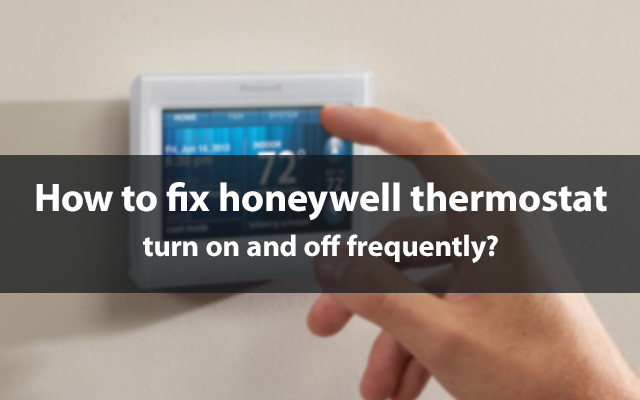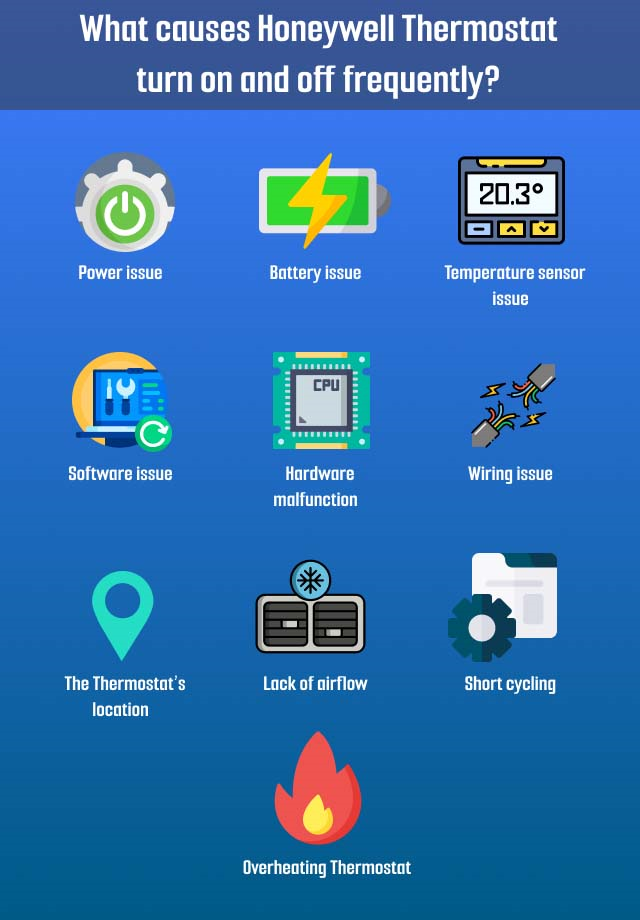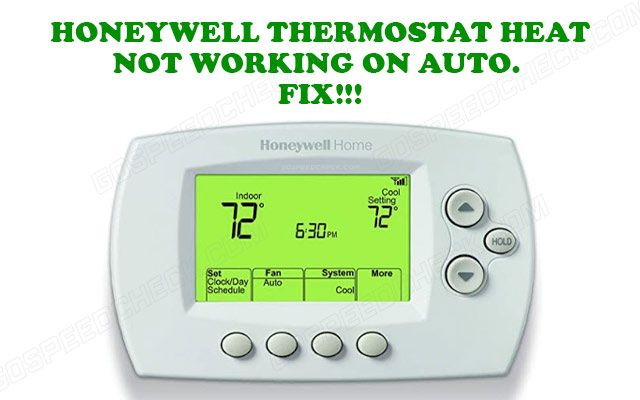Honeywell Thermostat turns ON and OFF frequently [Disclosed]
Honeywell Thermostat turns on and off frequently is a fairly typical issue.
If not identified and resolved immediately away, it may result in greater utility costs and more costly thermostat repairs.
The thermostat might need to be replaced if it has been on for too long.
Following a brief discussion of several potential causes, let's move on to some troubleshooting techniques:

Honeywell Thermostat turns on and off frequently issue
Why Honeywell Thermostat turns on and off frequently?
There may be issues with the Honeywell Thermostat's power source causing it to turn on and off.
That is to say, if there is an unexpected power interruption, your thermostat may switch off and then turn back on after the energy is restored.
With that in mind, the following is the reason why your Honeywell thermostat display turns on and off frequently:

Factors that cause Honeywell Thermostat turns on and off frequently
Power issue
The Honeywell smart thermostat may cut off unexpectedly and then come back on after a power outage affects your entire home.
Battery issue
Battery issue can also cause the Honeywell thermostat turning on and off. That time, you can reboot the thermostat to fix worn-out batteries.
.png)
Battery issue
Temperature sensor issue
The Honeywell Thermostat's power supply could suffer if the device's temperature sensors develop a malfunction.
Software issue
The device's outages may be caused by a problem with its interface, or more precisely, by improper settings.
Hardware malfunction
A motherboard problem or whole or partial hardware damage to your device could be to blame for the thermostat outages.
.png)
Hardware malfunction
Wiring issue
Your Honeywell Thermostat AC turns on and off frequently if any of the wires attached to it are frayed or broken.
It's important to rule out this problem because frayed or loose wires can cause far more serious issues, like a fire.
If any wires are slack, you should tighten them, and you should get professional help if anything seems to be burned or damaged in any way.
The Thermostat’s location
Your thermostat would have been installed in the ideal spot when your house was built and your HVAC system was installed.
Your thermostat may have stopped down as a result of any remodeling you may have done or even just a simple move.
Here are some suggestions for the ideal site.
-
Out of direct sunlight
-
Away from anything that generates heat
-
Close to doors or windows
.png)
The Thermostat’s location
Lack of airflow
The volume of air that each HVAC system needs to function is different.
Your blower motor or even the compressor on your air conditioner may overheat if there is not enough air flowing through them.
Either filthy air filters or clogged evaporator coils are frequently the cause of airflow obstructions.
In either situation, harm may result from the dust, dirt, or debris.
Any of the aforementioned scenarios may result in your system shutting down and ceasing to respond to the call of your thermostat.
Here, routine maintenance is crucial.
Overheating Thermostat
The device may overheat if it has to work too hard to keep the desired temperature.
The thermostat will automatically turn off if the temperature rises above a predetermined threshold.
The gadget will often restart as soon as it has a chance to cool down.
Regardingheat, many people face the issue of Honeywell Thermostat heat not working on auto.
So check our post to know how to fix it!
Short cycling
When your furnace or air conditioner cycles on and off more quickly than it should, this is referred to as short cycling.
.png)
Obstructed air filters
Either way, it needs to be addressed because it may be a little sign of a larger issue.
Short cycling has a number of frequent causes, including:
-
Obstructed air filters
-
Unsuitable-sized HVAC apparatus
-
Leaked refrigerant
A specialist will need to handle it if you suspect a refrigerant leak or low refrigerant levels.
How to fix Honeywell Thermostat turns on and off frequently?
The methods provided below are designed to address a variety of problems, including arbitrary restarts.
To ensure that the fixes are successful, keep in mind that you must implement them in the order that we've mentioned them, in a straight line.
Change your air filters
If you don't change your air filters often enough, they will accumulate dirt and become clogged, which will make the heat exchanger retain heat and eventually overheat.
You need to replace your air filters every 90 days, unless you have allergies or pets.
If you have allergies or own dogs, you must replace your air purifiers every 60 days, or even sooner if you have severe allergies.
.png)
Change the air filters
Check the temperature
Thermostats from older models may be defective.
You should switch to a digital thermostat right now if you've been considering it.
Make sure the settings are accurate on your smart thermostat by checking them twice.
Even if a thermostat is correctly set, a replacement thermostat can aid in removing the risk that it is faulty.
An unreliable connection may potentially be the source of short cycling.
By getting in touch with the HVAC professional who installed your system, you can verify that your HVAC system is sized correctly and that your thermostat is set to the proper setting.
.png)
Pay attention to the temperature
Hard reset
To fix the problem, you should start with a hard reset.
The random outages your device is now experiencing should stop as a result of this operation, which drains your thermostat of any leftover electricity.
Here's how to force the Honeywell Thermostat to reset:
-
Remove the back panel of your gadget
-
Carefully eject the batteries
-
Then wait five minutes for the device to discharge
-
Place the batteries back in and shut the compartment
Note: In order to do a proper hard reset and power cycle, the power source must typically be removed for at least five minutes.
Any lower than that, and your gadget might not discharge sufficiently, preventing a full power cycle.
Replace batteries
Your thermostat batteries may be deteriorating if your Honeywell Thermostat turns on and off frequently.
To stop the unpredictable outages of your thermostat, you should next change the batteries.
.png)
Replace Honeywell Thermostat’s batteries
Follow these instructions to learn how to replace your batteries:
-
Carefully remove the back panel to reveal the batteries
-
Take the batteries out
-
Replace the back panel
-
Install the new batteries
It's important to pay attention to how you insert the new batteries so they establish proper contact with the power poles.
Flip the HVAC breaker
Your HVAC system's beaker may occasionally trip, requiring you to turn it back on.
Although it happens infrequently, having the switch flipped to the OFF side may also prevent your thermostat from being turned on instead of causing it to shut down.
By simply turning the breaker switch to the ON position, you can turn the breaker.
The breaker switch is over the AC pipe in the room with the HVAC furnace. For your system to work, make sure it is turned to the left.
Tip: If the circuit breaker switch is on, we advise turning it off, waiting a short while, then flipping it back on to test the display once more.
Measure sensor temperature
There is a chance that the mercury sensor is misreading the temperature when you apply a temperature.
Only your thermostat's temperature sensors are at blame in this situation.
.png)
You need to measure sensor temperature
Apply the following guidelines to understand how to check the temperature and resolve sensor problems:
-
Make sure your thermostat is set to heat
-
Take a thermometer out of your pocket and check the temperature
-
Verify that the two temperatures match
Note: The temperature sensors will need to be changed if they are out of alignment.
If they aren't changed right away, they could lead to operational problems, necessitating the replacement of the complete thermostat.
Factory reset
Honeywell Thermostat factory reset is also referred to as "battery flip flop" because it directly affects the device's charge.
In the event that the reset doesn't resolve the Honeywell Thermostat AC turns on and off frequently problems, resetting your thermostat will also be helpful.
To perform a Honeywell Thermostat reset, follow these steps:
-
To access the batteries, open the rear panel
-
Take them out and reposition them
-
Carefully remove each one of the batteries one at a time after waiting for around five seconds
-
Reposition the batteries
-
Reclose the back panel
.png)
Factory Reset
Note: The thermostat won't operate if the batteries are in the wrong place inside; avoid doing this before trying to switch it on.
Well, besides the Honeywell Thermostat-related issues, we can also help you solve many problems regarding your Internet, like how to run a Wifi speed test.
If you have slow Wifi speeds, you can find useful tips on your blog as well!
Why does Honeywell Thermostat go blank then come back on?
You won't be able to operate your heating and cooling system without a functioning thermostat.
It's crucial to know what can make a device shut down, for this reason.
In the event that your Honeywell Thermostat is faulty or overheating, it may continually shut off.
The thermostat can also be made to shut off by the HVAC system; potential causes include a clogged condensate line, insufficient airflow, and brief cycling.
.png)
Why does Honeywell Thermostat go blank then come back on?
A faulty thermostat may be to blame for short cycling.
The simplest and easiest thing you can do if your furnace is short cycling is to examine if your thermostat is working properly.
The system will shorten the cycle as a result.
You can use these approaches to check if your thermostat is bad:
Thermostat has no power
AC or Furnace won’t turn on
Heater or AC won’t turn off
Thermostat doesn’t match room temperature
Thermostat doesn’t respond
Short cycling
Thermostat forgets programmed settings
The average home thermostat lasts 10 years.
However, as more recent, more effective thermostats hit the market, you could need to replace yours sooner.
Conclusion
If you run into any problems when troubleshooting, don't be afraid to contact Honeywell for more assistance! We hope that after understanding how to fix a Honeywell Thermostat turns on and off frequently, you should be able to do so without much effort. Good luck!






6 Comments
Kimberly Turner
Ay, thank you for this! Excited to dive in.
Leave a Comment
Your email address will not be published. Required fields are marked *MySpeed
Awesome
Leave a Comment
Your email address will not be published. Required fields are marked *Melissa Johnson
Why won't my thermostat stay where I set it?
Leave a Comment
Your email address will not be published. Required fields are marked *MySpeed
In fact, build up of dirt and dust on your thermostat and mechanical contacts can interfere with how it reads your settings
Leave a Comment
Your email address will not be published. Required fields are marked *Margaret Harrison
What are the symptoms of a failing thermostat?
Leave a Comment
Your email address will not be published. Required fields are marked *MySpeed
Some symptoms of thermostat failure can be named: leaking coolant, unusual noises, increased fuel consumption, erratic changes in temperature, etc
Leave a Comment
Your email address will not be published. Required fields are marked *Leave a Comment
Your email address will not be published. Required fields are marked *